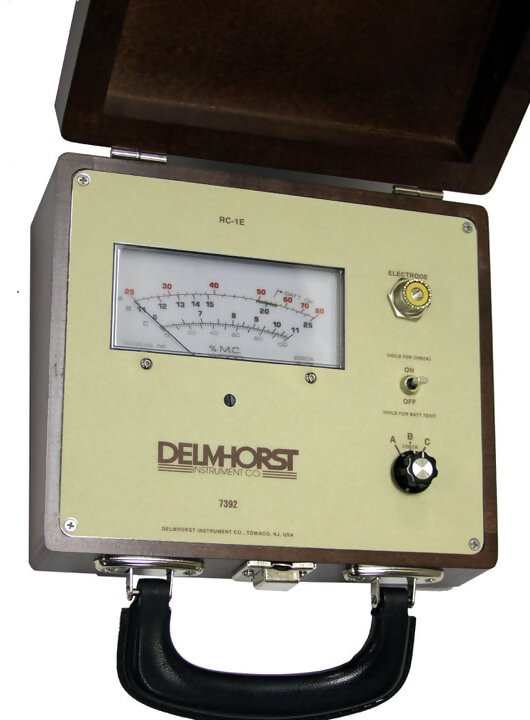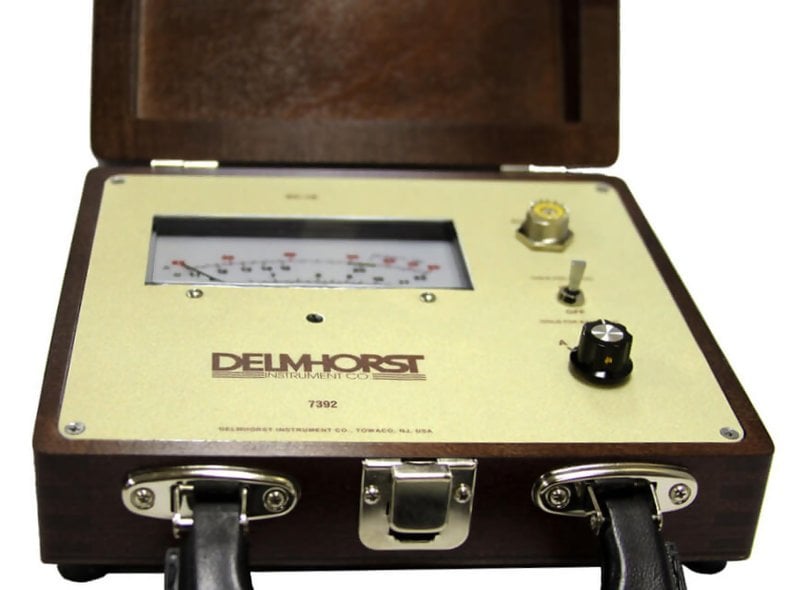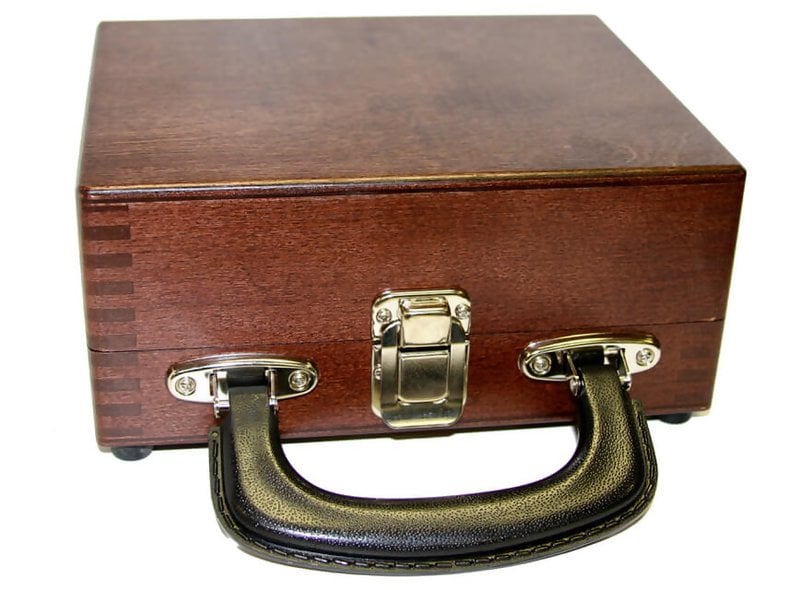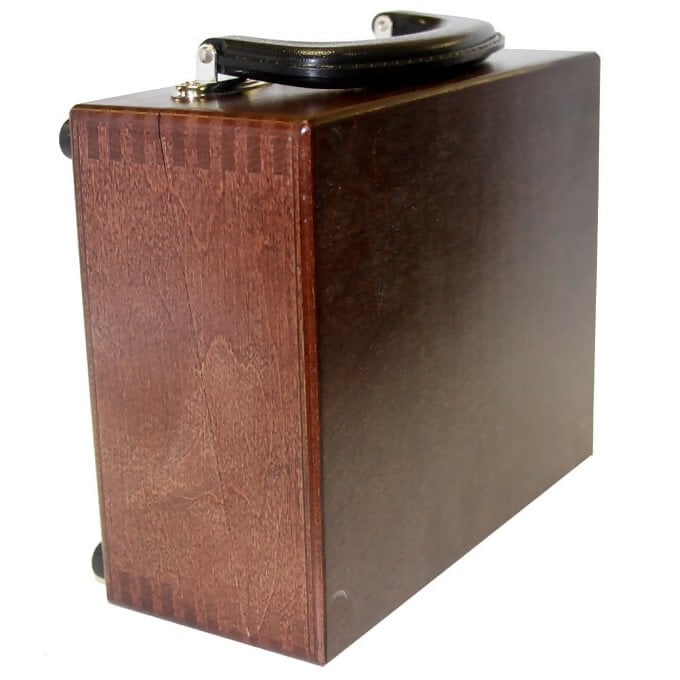Delmhorst RC-1E Wood Moisture Meter
Easy-to-read analog display
Measures moisture in gypsum using a three-range scale: (0.2%-1%, 1%-8%, and 8%-50%)
Built-in battery and calibration check
Clad in a durable and beautifully finished hardwood case, the RC-1E’s classic design and wide moisture measurement range make it a valuable addition to your toolkit. The Delmhorst RC-1E Wood Moisture Meter has been a favorite among dry kiln operators for years.
Kit Contents
- Delmhorst RC-1E Wood Moisture Meter
- Instructions
Features
- Easy-to-read analog display.
- Measures moisture in Douglas Fir using a three-range scale (6%-80%, 6%-11%, 11%-25% , and 25%-80%).
- Also available with Southern Pine correction as RC-1E/SP.
- Built-in calibration check.
- Built-in battery check.
- Auto shut-off timer.
- Size: 6 1/2" X 8" X 3".
- Weight: 3 lbs. 8 oz.
- Rugged construction ensures years of reliable use.
- 9V battery.
- 1-year warranty.
Related Products
2497/A-100
- Uninsulated pin and retainer with 5/16" penetration. Standard on all meters with built-in pins and the 2-E and 4-E electrodes. Used on wood up to 6/4 (1 ½”), concrete and gypsum
496
496 contact pins are insulated except at the tips, and measure 2" overall with 1 1/8" penetration. Standard on the 26-ES, and can be used to check wood up to 5" thick
608- The 608 insulated contact pins measure 4" overall, and penetrate 3 1/4". Standard on 21-E and 18-ES electrodes, and can be used on roofing, insulation, timber, poles, and EIFS. Also available in 7” length with 6” penetration as 608/001
A-111- Another alternative to the 496, the A-111 is an uninsulated contact pin measures 1 7/16” and has 1/2" penetration. The A-111 is compatible with both the 26-ES and the 22-E, and its tapered point makes it easier to penetrate into hard surfaces. Can be used on wood up to 2" thick
MCS-1 - Moisture content standards are great for verifying that your Delmhorst moisture meter is in calibration. The MCS-1 can be used on any meter with a wood scale. With two electrical resistance values (12% and 22%) to test your meter against, you can be sure that your readings will stand up to the strictest standards of accuracy. The MCS-1 is also available with a letter of certification traceable to NIST
15-E - Pin type, with two rows of four pins each, maximum penetration 1/8". Penetration can be adjusted according to stock thickness by means of gauge block. Used for veneer
18-ES - Similar to 26-ES, the 18-ES has a 17" steel shaft. Comes with 608 insulated pins for 3 1/4" penetration. Ideal for timber, poles, and ties.
- Also offered - 18-ED - with depth gauge to measure pin penetration
22-E
- Comes with A-111 uninsulated contact pins for 1 1/2" penetration. For use on plaster, masonry and wood. Will also accept 496, insulated pins; 1 1/16” penetration
- 22-E is also available as the 22- ET with a tapped handle for hard to reach areas
26-ES
The 496 contact pins that come with the 26-ES penetrate 1 1/8” and have insulated shanks so that only the tips are exposed. The pins make contact only at their uncoated tips and provide much more accurate readings of moisture content at various levels of penetration. This feature is useful for a variety of different applications
- Flooring installers: Penetrate through flooring to plywood sub-floor, or concrete.
- Dry kiln operators: Identify moisture gradients which helps to identify the drying pattern.
- Furniture manufacturers and craftsmen: Easily check high density hardwood that short pins are unable to penetrate
Also available as the 26-ED, which includes gauge to measure pin penetration depth
2-E
Fitted with the same 5/16" penetration pins that are mounted on our pin type meters. This electrode is great for a variety of different applications:
- Home inspector: Use on wood joists and drywall.
- Paper producer: Use on curved surfaces such as cardboard and paper tubes.
- Woodworker: Use on timber, poles, and veneer.
2-E is also available as the 2- ET with a tapped handle for hard to reach areas. Can also be fitted with A-103 uninsulated pins with 1 3/32” length and 11/16” penetration.
42-E/B
- T-handle electrode with 3/8" penetration to check moisture in stacks in or out of the kiln. Stickers must be at least 5/8". Also offered in and 4 1/2 ft. length as 42-EB/4-5.
4-E
Comes with 4 uninsulated 2497/A-100 contact pins for 5/16" penetration. Useful for
- Dry-kiln operators: Use on kiln-dried boards up to 2" and on air-dried boards up to 5/4
- Leather producers: Use for tough leather
Downloads
F.A.Q.
Why should i use a Moisture Meter?
Structurally sound and beautiful in appearance, wood is the ideal raw material. Flooring professionals know that Moisture content is the single most important factor affecting the quality of a wood flooring installation.
To ensure quality from the manufacturer to the final installation, Delmhorst offers a full range of Moisture Meters that help minimize defects such as shrinkage, cracks, and splits. Years of experience, high-tech tools and controls, and premium grade wood cannot make a difference if Moisture content goes unchecked.
How does a Moisture Meter work?
There are two types of Moisture Meters typically used in the flooring industry. Pin-type Meters, which utilize the principle of electrical resistance, use wood or other hygroscopic materials as an element in a circuit by driving two pins or electrodes into it.
Pinless Meters use radio frequency signals to penetrate the material being tested. There is no pin intrusion into the surface of the material you are checking.
Which type of Moisture Meter works best for a flooring job?
To quickly identify wet areas in floors, pinless Meters are easy to use. They offer the convenience of testing a large area quickly, and help you determine if further testing is required in certain spots. A pinless Meter may also be used to determine if water-born finishes are dry and ready for a second application.
A pin type Meter, on the other hand, is the best way to identify the exact location of Moisture in sub-floors. The key to finding hidden Moisture is to use an electrode with insulated contact pins. These pins read only at their un-insulated pin tips, allowing the contractor to drive the pins into the floor and through to the sub-floor, noting readings at each level of penetration.
What are the ideal Moisture conditions for the sub-floor and wood flooring so problems can be avoided?
Flooring strips or planks - and the sub-floor - should be brought to equilibrium before installation. Best results are obtained when the wood sub-floor is within 4% MC of the flooring, maximum.
If the floor is on concrete, especially a slab on grade, the challenge is to be sure that the slab is dry and not likely to pick up Moisture later on. Please refer to the Operating Instructions section under PRODUCT SUPPORT for more info.
Why doesn't the Meter give Moisture content in percent on concrete?
Because the exact makeup of concrete is usually unknown, it is virtually impossible to provide a %MC calibration. Delmhorst Moisture Meters feature a 0-100 reference scale that provides “dry to wet” indications of the presence of Moisture. Factors that affect concrete Moisture readings include it's mix ratio and type, voids, and depth that the pin penetrates.
How does static electricity affect Meter readings?
In cold and/or dry climates, static charges may cause erratic Meter readings in the range below 8 percent. Measuring such high resistance under these conditions is difficult enough, but the winter months can make it more so. The analog Meter pointer "jumps" all over the scale or the digital display may flash erratic numbers. To minimize the effect of static:
- Try not to let the electrode cable dangle.
- Drive the electrode pins into the wood with the Meter turned off, and then turn the Meter on when you are ready to take the reading.
- After driving the pins, place your hands next to them on each side of the electrode to help discharge the static from the board.
- You can also try passing a damp cloth over the board's surface to pick up any static charges before driving the pins.
These suggestions are not guaranteed. However, depending on the conditions, any one of them can work, either alone or in combination with another.
Are there board width limitations in using Moisture Meters?
Board width is not a limiting factor when using a pin type Moisture Meter. As long as the pins make good contact, the Meter can be used on anything from small dowels to wide planks.
For accurate results with a pinless Meter, the material you're testing must be at least the width of the scanning area on the bottom of the Meter. Otherwise the Meter will not make firm contact with the board and may provide inconsistent, unreliable readings.
How Do Delmhorst Meters Handle Readings on Rough-Surfaced Lumber and Cupped Boards?
With a pin-type Meter, these conditions are not a problem. Just drive the pins as you would normally, insuring firm, positive contact and detect unknown gradients.
Pinless Meters, however, need firm contact to a flat surface so their readings on uneven surfaces may be unreliable.
How do i determine if the Moisture problem is in the finished floor or the sub floor?
In order to find this out, you must use a pin type Meter with insulated contact pins. First, take several readings in the layer just below the surface; then make a series of core readings, closer to the center of the board thickness. After you have noted these readings, hammer the pins through the flooring material until you make contact with the sub floor.
If your readings throughout this process are uniform, then there is not a Moisture problem. If readings increase as you go further into the floor, and again in the sub floor, this indicates that the sub floor is a source of Moisture.
How does temperature affect the accuracy of Meter readings?
After Moisture content and a Moisture gradient, if one exists, wood temperature is the most important factor affecting the accuracy of your readings. As wood temperature increases its electrical resistance decreases and indicated Moisture content rises. The lower the temperature, the lower the indicated Moisture content. Depending on the temperature and Moisture content, you may have to make a correction.
Does the glue used in plywood affect Meter accuracy?
In most cases, no. To verify this, use insulated pin to make individual tests by touching the outer ply, glue lines, and center plys. If the glue reads the same as wood, use the Meter on plywood as you would any solid material and take the readings at face value, without species correction.
How Do I Keep a Delmhorst Meter in Good Working Condition?
Delmhorst moisture meters are well known for their ruggedness and ability to withstand years of rough handling. Like any testing instrument, a little care goes a long way toward trouble-free service:
- Store the meter in clean, dry place
- Change batteries and pins as needed
- Keep the meter and electrode clean by using any biodegradable cleanser sparingly on external parts only.
If you have any further questions on using a moisture meter for flooring applications



















